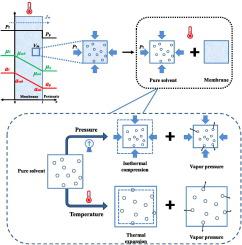Desalination ( IF 8.3 ) Pub Date : 2021-01-06 , DOI: 10.1016/j.desal.2020.114905 William Mickols , Zhaohuan Mai , Bart van der Bruggen

|
The activity coefficients and equations for transport through nanofiltration (NF) and reverse osmosis (RO) membranes were derived to determine the contribution of the heat of vaporization, molar volume, activation energy (diffusion), thermal expansion, and liquid- and vapor-phase compression. These equations have been derived for pure substances; hence, the measured deviations were obtained from the membrane itself. The inclusion of these effects provides a more accurate prediction of membrane transport than that provided by current models. The model presented herein accurately determined fluxes over temperature and pressure ranges for four different membranes, which the Merten model failed to determine. The transport activity model was applied to water, ethanol, methanol, and n-hexane. The molar volume of water for commercial, brackish-water membranes was approximately equal to that of bulk water, while high-flux brackish-water and NF membranes exhibited significantly lower molar volumes, as compared to that of the bulk water. Surprisingly, slight changes in the molar volumes of water, ethanol, and n-hexane in organic NF membranes were observed. Significant changes in the physicochemical properties of water were identified in the Desal 5 membrane. These results indicate that the molar volume and compressibility enabled the pressure dependence of the RO and NF membranes. For all the membrane types, the resistance to flow, heat of vaporization, and diffusion coefficients controlled the magnitude of changes in flux due to pressure and temperature.
中文翻译:

压力和温度对溶剂在纳滤和反渗透膜上的迁移的影响:基于活性的迁移模型
推导了通过纳滤(NF)和反渗透(RO)膜传输的活度系数和方程式,以确定汽化热,摩尔体积,活化能(扩散),热膨胀以及液相和气相的贡献压缩。这些方程是针对纯物质得出的;因此,测得的偏差是从膜片本身获得的。与当前模型提供的结果相比,这些效果的包含可提供对膜转运的更准确的预测。本文介绍的模型可精确确定四种不同膜在温度和压力范围内的通量,而Merten模型无法确定。转运活性模型应用于水,乙醇,甲醇,和Ñ正己烷。商用微咸水膜的水的摩尔体积大约等于散装水的摩尔体积,而高通量微咸水和NF膜的摩尔体积比散装水的摩尔体积低得多。出人意料的是,在水,乙醇的摩尔体积的微小变化,并Ñ观察到有机NF膜-己烷。在Desal 5膜中发现了水的物理化学性质发生了显着变化。这些结果表明,摩尔体积和可压缩性使得RO和NF膜的压力依赖性成为可能。对于所有类型的膜,流动阻力,汽化热和扩散系数控制着因压力和温度引起的通量变化幅度。











































 京公网安备 11010802027423号
京公网安备 11010802027423号